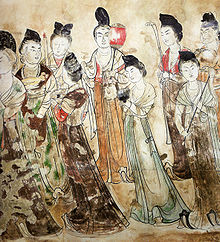Princess Yongtai (Chinese: 永泰公主; Wade–Giles: Yung-t'ai), born Li Xianhui (Chinese: 李仙蕙; pinyin: Lǐ Xiānhuì); 685 – October 9, 701[3][4]), courtesy name Nonghui (穠輝), was a princess of the Tang dynasty.
| Princess Yongtai 永泰公主 | |||||
|---|---|---|---|---|---|
 Tang court ladies from a mural in Li Xianhui's tomb. The actual murals have been replaced by replicas, as the originals are now kept in the Shaanxi History Museum to better preserve them.[1][2] | |||||
| Born | 685 | ||||
| Died | October 9, 701 (aged 15–16) | ||||
| Burial | |||||
| Spouse | Wu Yanji, Prince of Wei | ||||
| |||||
| Clan | House of Li | ||||
| Father | Emperor Zhongzong of Tang | ||||
| Mother | Empress Wei | ||||
Biography edit
Li was the seventh daughter of Emperor Zhongzong of Tang and the second daughter of Empress Wei. She married Wu Yanji (武延基), Prince of Wei, a grandnephew of Wu Zetian.[5]
Death edit
The cause of Princess Yongtai's death is widely disputed. According to her brother's biography in both the Old and New Books of Tang, she, her husband and her brother were found to have criticised Wu Zetian's lovers Zhang Yizhi and Zhang Changzong and were caned to death. In the Zizhi Tongjian, the three were forced to commit suicide. In contrast, the epitaph from her tomb states that she died in childbirth. After Wu Zetian's death, when her father again came to the throne, she and her brother were reburied in grand tombs in the Qianling Mausoleum in 705.[6]
Tomb edit
Li's tomb was discovered in 1960, and excavated from 1964. Among the Qianling Mausoleum burials, Li's is the largest belonging to a woman.[7] It had been robbed in the past, probably soon after the burial, and items in precious materials taken, but the thieves had not bothered with the over 800 pottery tomb figures, and the extensive frescoes were untouched. The robbers had left in a hurry, leaving silver items scattered around, and the corpse of one of their number. The tomb had a flattened pyramid rising 12 metres above ground, and a long sloping entrance tunnel lined with frescoes, leading to an ante-chamber and the tomb chamber itself, 12 metres below ground level with a high domed roof.[8] Most of the contents, including the frescoes, are now in the Shaanxi History Museum.
The frescoes depicted the four deities, ceremonial weaponry, daily life in the imperial court, and celestial bodies. The tomb also provides an example of Tang dynasty architecture, with depictions of buildings and caisson motifs.[9] The main subject of the frescoes is women, the majority of whom are shown without make-up and wearing no jewellery.[10] There are also several carved human figures, who seem to be ladies-in-waiting.[11]
-
Paintings from the wall of the tomb.
-
Roof of the tomb.
-
Stone sarcophagus of Princess Yongtai (side view, reproduction), Qianling Museum. Designed as a stone house with hip-and-gable roof, it is comparable to the sarcophagus of Li Jingxun, although much larger with a surface of 40 square meters.[12][13]
-
Epitaph of Princess Yongtai
See also edit
Notes edit
- ^ The Tomb of Princess Yongtai. TravelChinaGuide. Retrieved 2008-02-11.
- ^ Shaanxi History Museum, archived from the original on 2005-05-04, retrieved 2016-11-12
- ^ Tombstone of the Deceased Princess Yongtai of Tang.
- ^ Academia Sinica Chinese-Western Calendar Converter.
- ^ "關於大唐最美公主——永泰公主李仙蕙死因的解析" [On the most beautiful Tang princess: resolving the Princess Yongtai Li Xianhui's cause of death] (in Chinese). KK News. 25 August 2016. Retrieved 14 March 2017.
- ^ Watson, 136; Hay, 51
- ^ Wang (2003), p. 59.
- ^ Watson, 136-141, Hay, passim throughout
- ^ Wang (2003), p. 59-64.
- ^ Wang (2003), p. 64.
- ^ Wang (2003), p. 67.
- ^ Qianlong Museum notice
- ^ Wu, Mandy Jui-man (2004). "Exotic Goods as Mortuary Display in Sui Dynasty Tombs--A Case Study of Li Jingxun's Tomb". Sino-Platonic Papers. 142.
References edit
- Hay, Jonathan (2010). "Seeing through dead eyes: How early Tang tombs staged the afterlife". RES: Anthropology and Aesthetics. Spring/Autumn (57/58). Peabody Museum of Archaeology and Ethnology, Harvard: 16–54. doi:10.1086/RESvn1ms25769971. JSTOR 25769971. S2CID 193597856.
- Wang, Xiaoli 晓莉 (2003). "永泰公主墓壁画题材及艺术特色" [Artistic characteristics and topics in the murals of the Princess Yongtai's tomb]. Wenbo (in Chinese) (5): 59–67.
- Watson, William (1973). The Genius of China: An exhibition of archaeological finds of the People's Republic of china held at the Royal Academy, London by permission of the President and Council from 29 September 1973 to 23 January 1974. London: Times Newspapers Ltd. ISBN 0723001073.